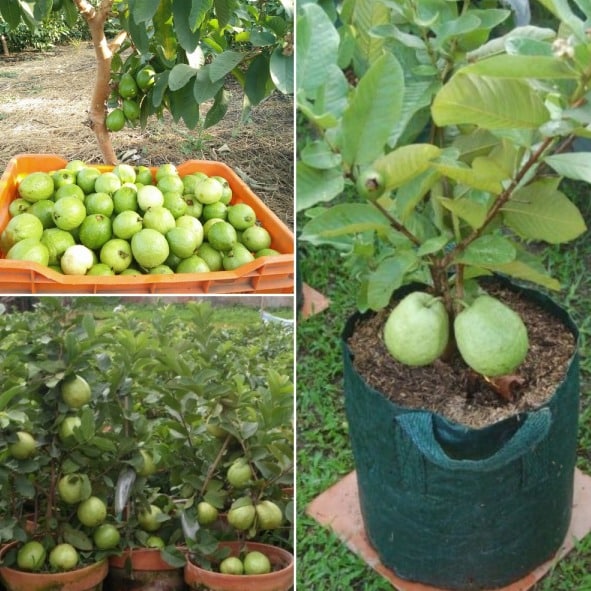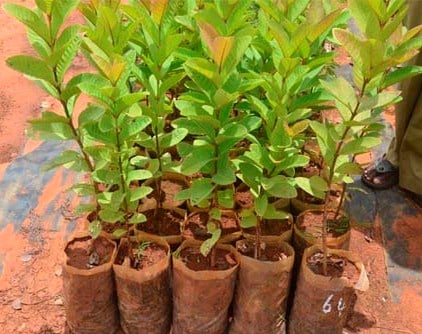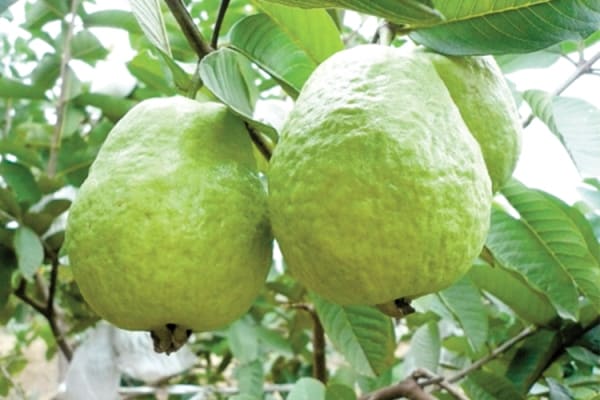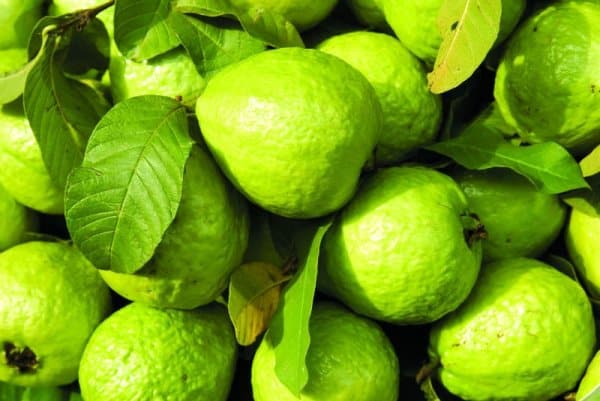Growing Guava in Pots:
The following information is all about Growing Guava In Pots.
Introduction to Guava
Guava is a common tropical fruit, cultivated in tropical and subtropical regions. Guava fruits are native to Mexico into South America. Guava is most frequently eaten species, have hard, dark green leaves that are opposite, elliptic to ovate. The flowers of the tree are in white color with five petals and numerous stamens. The guava fruits will be light to dark green hard skin with white or red seeded soft and juicy flesh. The guava fruit is about 4 to 5 inches diameter, in oval, round or pear shapes. Guava us one of the few tropical fruit trees that can be grown in pots. Guava is the richest source of dietary fiber and vitamin C with moderate levels of folic acid. The taste of guava depends on the variety some have sour, and some have a sweet taste. The guava when grown in the ground, the tree grows up to 12 feet and when grown in pots the tree will grow in small size. The guava trees thrive well moist-well drained soil with pH levels 5 to 7. Guava loves the hot and humid climate, but cannot tolerate freezing winters. The Guava tree is self a sufficient plant, and don’t require much maintenance. The guava plant starts producing fruits after 2 months of blooming. Let us talk more about growing guava in pots.
- Scientific Name for Guava: Psidium Guajava.
- Common Names for Guava: Amrood, Amrut Phala, Common Guava, Lemon Guava, Goyabe, Psidium, and Red Guava, etc.
- Family: Guava belongs to the family Myrtle.
Varieties for Growing Guava in Pots

Guava fruits usually have 4 to 10-centimeter-long and are round or oval shaped depending on the species. The skin of the guava fruits has rough to smooth surfaces with sour taste, or soft or sweet. Thickness of the skin depends on the species and the outer skin, usually green before ripening and turns yellow, maroon, or green when ripe. The seeded pulp inside with an amazing sweet and sour taste and pulp will be in off-white to deep pink.
- Tropical White (P. Guajava Creama): It has juicy white flesh with sweet aroma. Skin of guava has light green and turns yellow when ripe. Cutting or grafting the stem is the ideal method to propagate this variety of guava, thrives in well-drained soil. This variety of guava tree prefers partial to full sun, and blooms in May and June. Spring is the ideal growing season, grows up to 4 to 5 feet. Suitable for growing in pots. The plant takes 2 to 3 years for fruiting and tree lives up to 40 years.
- Tropical Pink (P. Guajava Rosa): It has a juicy pink, smooth flesh with a sweet taste. The skin turns from green to yellow when ripens. Cutting/grafting the stem is the ideal method of propagating. It need well-drained soil with pH level 7. This variety guava trees prefer full sun and suitable for growing in pots. Dwarf varieties of this guava tree grown up to 4 to 5 feet. After blooming it takes hardly takes 1 ear to bear fruits.
- Tropical yellow (P.Guajava Mexican Rosa): It is known as Mexican Cream. It bears a medium-sized round fruit with light yellow colored skin blushed with red. Fruit has creame flesh with a sweet taste. This guava tree grows well in tropical and sub-tropical regions and suitable growing in pots. The dwarf tree grown up to 3 to 4 feet and takes 3 to 4 years to bear fruits. Grows in well-drained soil with pH levels 6 to 7. Requires full sun to thrive and grows well in spring.
- Red Malaysian (P. Guajava rojo Malaysia): these guavas have a red colored skin with pink flesh, it not grown for fruits but also a for ornamental purpose. It has deep red colored foliage with bright pink flowers. Grows well in tropical, subtropical and temperate regions. thrives in a wide range of soils with pH levels 6 to 7. Requires partial to full sun and can be propagated by cuttings.
- Strawberry Guava: Dark red skinned guava, with a cream colored, juicy pulp has an excellent strawberry flavor. Fruits appear from small to medium sized. Grows well in partial to full sun and most suitable tree for container gardening. This guava can be propagated from both seeds and cuttings. Thrives in well-drained soil with a good amount of water supply.
- Lemon Guava: It is tropical plant well suited for container gardening. It has oval shaped fruits with a yellow colored outer skin with cream colored, juicy flesh with seeds at the center. This tree grows up to 2 to 4 feet height and thrives well in full to partial sun. thrives in well-drained soil with neutral pH levels.
- Pineapple Guava: It is slow growing guava trees, produces oval shaped guavas with flavor of pineapple and mint. Grows well in acidic soil that is rich and well-drained. And requires full sun to thrive and suitable for growing in tropical regions.
Suitable Pots for Growing Guava in Pots
- Guava tree needs a medium to large pots for growing, selecting dwarf varieties are recommended as they stay compact.
- Select the container that holds minimum 3 to 5 gallons of potting soil.
- The ideal size of pots for growing dwarf guava tree can be 14 inches depth and 13-inch width.
- If growing normal guava in a pot, prune the plant regularly to keep the size compact.
- Repotting is preferred during the spring seasons.
- Select a container made of plastic, clay, terracotta or ceramic. Guava tree prefers full sun to thrive and plastic container can get cracks when exposed in sun long periods.
- Pots should have a good draining system.
Soil Requirement for Growing Guava in Pots
- Guava grows well in a wide range of soils, but uses well-drained, fertile soil for growing in pots.
- The pH levels of the soil should be around 4.5 to 7.0.
- Mix the soil with organic manure and perlite or vermiculite to increase its fertility and draining capacity
- It is recommended to use good quality commercial potting that is rich in organic matter for growing guava in pots.
- Mixing the potting with natural compost or slow release fertilizer is preferred to fasten the growth of the plant.
Temperature Requirement for Growing Guava in Pots
- Guava plants are drought and temperature resistant.
- The ideal temperature of seed germination is 20 to 28 °C.
- Young guava trees are affected b cool winter temperatures, temperature below -3 °C can harm the plants.
- Guava trees above 3 years can bear temperatures can tolerate temperature below -6 °C.
- Pots of guava can be moved indoors when the temperature falls below the -6 °C.
- If growing in mild winter regions, the pots can be placed outdoors even in winter.
Propagation Methods for Growing Guava in Pots
Guava can be propagated from seeds and cuttings. Growing guava trees from seeds is a bit long term procedure, propagating through cuttings is recommended.
Growing Guava in Pots from Seeds:

- Guava seeds have high and fast germination rate.
- Buy good quality seeds from the best source. Fresh guava seeds can also be used for sowing. But is better to buy seeds from nurseries or online stores.
- If you are planning to grow from seeds from fresh guava fruit, first rinse the seeds thoroughly with water and wrap them in paper towel. Dry the seeds for a couple of hours and then soak them in warm water.
- If growing from nursery seeds, soak the seeds in warm water overnight, this process fasten the germination process.
- Now fill the seedling tray or pots with seed starting mix, sow the seeds.
- And place them in a warm, bright location, maintain moisture levels in soil constantly.
- Cover the pots with plastic cover to speed up germination.
- Guava seeds take 4 to 5 weeks for germination. Germination period depends upon climate and seed quality.
- Once the seeds germinate, remove the cover and place it in full sun and water thoroughly.
- Young guava plants cannot tolerate freezing winters, place the pots in indoors during temperature fall.
- Once the plant grows up to 8 to 10 inches, transplant it into desired container.
- Start feeding the plant after the age of 1 year. A Guava tree grown from seeds takes 4 to 5 years to mature and produce fruits.
- So, it is recommended to grow guava from cutting and buy a grafted guava tree form nurseries or garden centers.
Growing Guava in Pots from Cuttings:
- Guava trees can be easily propagated from cuttings.
- Choose a healthy stem of new growth that is relatively firm. Cut off the terminals up to 6 to 8 inches and it should have 3 to 4 nodes worth of leaves on it.
- Cutting should be planted immediately don’t store it for more than 24 hours.
- Fill the desired container with rich potting mix and plant the cutting, to fasten the root formation treat the tip with rooting hormone.
- Place the container in a warm location, ideal temperature should be 24 to 29 °C.
- Keep the soil moist constantly and maintain humidity levels by misting the cutting at frequent intervals.
- The cuttings take 6 to 8 weeks to develop roots, and it takes 5 to 6 months for the plant to establish with complete root system.
- Once the plant gets firm, start feeding it at regular intervals.
Guava can be easily grown from seeds and cuttings, but we recommended to buy a grafted tree from the nurseries and start growing, it will be a very easy procedure and can harvest fruits in a short period. Select a desired variety tree that is temperature tolerant and drought tolerant.
Location for Growing Guava in Pots
- Guava trees love the warm and humid climate.
- Guava is a tropical plant, that can be easily adaptable to all the temperatures except the freezing winters.
- Place the pot in a location where it receives minimum 4 to 5 hours of sunlight and gets some shade in the afternoon.
- If growing in colder regions, place the pots in a location where it gets full sun.
- Guava pots can be placed on balconies, front yards, back yards, and in terrace gardens.
- Some varieties guava tree can be placed indoors where it can get partial sunlight. Window sill is the best location in indoors.
Watering Requirements for Growing Guava in Pots
- Guava tree prefers good watering at regular intervals. Allow the soil to dry between the watering intervals.
- During growing seasons, water plant once in a day, and in winter water once in a week.
- While watering, apply water only to the base of the plant. Don’t sprinkle water on the foliage, it may cause fungal diseases.
- Keeping the soil moist constant moist during the fruiting period will develop a juicy and sweet fruit.
- Rainwater is the best feed to guava plant, they grow healthy with rain water.
Mulching Requirement for Growing Guava in Pots
- Mulching is not compulsory but it has some benefits for guava trees.
- Organic mulching will preserve the soil moisture. Mulching helps in protecting the roots of the plant from the winters.
- Keep mulch away from the stem, contact with stem may cause fungal infections in the tree.
- Mulching prevents weeds and reduce risk of some pests.
Pruning Requirement for Growing Guava in Pots
- Pruning keeps the plant compact, pruning is compulsory for guava trees.
- Pruning keeps the tree in desired shape and size to develop a strong structure, and a healthy plant with more fruits.
- Prune the dead and diseased branches regularly. And prune the unbranched shoots and the crossing branches that blocks the sunlight to the base of the tree.
- Pruning should be done after harvesting and at the beginning of the growing season.
Winter Care for Growing Guava in Pots

- Guava trees are less resistant to freezing temperatures.
- During low temperatures cover the plants with garden cloches or blankets or plastic covers.
- Or pots can be moved to indoor during night and can be moved to outdoor during the day.
Pollination for Growing Guava in Pots
- Guava tree flowers in early spring, and in mild climates the bloom round the year.
- Most of the guava varieties are self-pollinated, if not honey bees will pollinate them.
- If no honey bees, use hand pollination. Pollinate the flower with smooth brush or cotton balls.
Fertilizers for Growing Guava in Pots
- Guava is a heavy feeder, feed the plant once in months when it is young and after that feed the tree for every two months.
- Use the fertilizers high in nitrogen, phosphorous, potash and magnesium for more yields.
- Feed the plant with 6-6-6-2 (N: P: K: Mg) fertilizer during the growing period once in a month.
- During the fruiting period feed the plants with composition 8:3:9:2 (N: P: K: Mg).
- Using fertilizer with high potassium will increase the yields. Use liquid organic fertilizer high in potassium before blooming for more fruits.
- Guava trees become iron deficient with high pH levels in the soil, so apply iron sulphate twice in a year.
- Spraying urea before the blooming period will increase fruit production.
- Fertilizing can cause burns on the leaves and stems, so water plant after fertilizing.
Pests and Diseases in Growing Guava in Pots
- Common pests that attack young guava trees are aphids, white fly, mealy bugs, moth, scale, and thrips.
- To protect fruits from pests wrap them with covers.
- Diseases that attack guava trees are anthracnose, red alga, and leaf spots.
- Too warm weathers can cause rust in trees, proper irrigation can control rust.
- Using a copper spray, neem oil spray or insecticidal soap spray can control the diseases.
- Ants are a severe problem for guava trees, use boric acid to control ants.
Harvesting Tips for Growing Guava in Pots

- Guava fruits mature in 3 to 4 months after blooming.
- Fruits can be picked in winter and in rainy season.
- Fruits picked in winter have a great taste.
- Guava can be harvested round the year in tropical regions.
- The fruit will be hard and green when picked early and changes its color and becomes soft when ripe.
- Green fruits can be stored in room temperature for more than a week, after that they start to ripen.
- Green guava fruits can stay green for more than a month when store in refrigerator.
Tips for Growing Guava in Pots
- During the first fruiting period, if the plant is week, dead head the flower and don’t allow them to fruit. A weak plant cannot produce sweet and juicy fruits. The plant can get well prepared for the second fruiting season.
- Don’t allow more than 5 to 6 fruits per branch, more fruits can create stress in branches. Cut off the fruits developing in a small and weak branch.
- Don’t plant guava tree in a large pot, repotting is the best option. Repotting can be done after harvesting period.
- Pruning regularly decreases the plant leaf and branch density and improves air circulation in the tree that protects from many diseases.
- No fruits in Guava: If the guava tree is not bearing fruit, allow the tree to dry and prune all the tips of the branches to stimulate the growth of the tree. Reducing watering intervals can make tree to improve defense mechanism that results flowering.
- Use only organic and granular fertilizer for the guava tree.
- Use combination of potting soil and organic compost to create a good growing medium for the plants.
- Guava trees grown in indoors should be fertilized with balanced fertilizer every week.
- Some famous guava varieties for growing in pots are Guava Ruby Supreme, Ruby Red, NANA Psidium Guajava, Patricia, Indonesian seedless, Indonesian White, etc.
- Grafting and Air layering is also the best methods to propagate guava when for commercial farming.
Thanks excellent informations for a beginners.